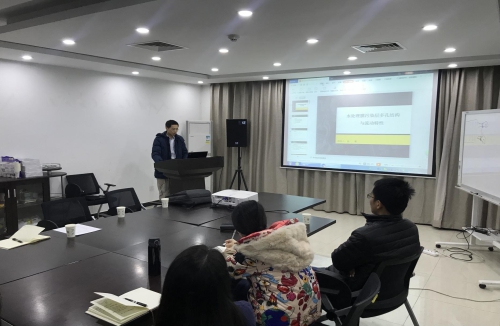Invited by the CAS Key Laboratory of Cryogenics and Beijing Key Laboratory of Thermal Science and Technology, Professor YANG Zhen from the Tsinghua University delivered a seminar entitled Porous Structure and Permeability of Polluted Layer of Water Treatment Membrane at TIPC on January 9th.
Professor YANG works at the department of energy and power engineering at Tsinghua University and is the winner of the 221 Basic Research Talents Award of Tsinghua University. From 2008 to 2010, he is engaged in postdoctoral research at the School of Mechanical Engineering of Purdue University in the United States, mainly engaged in gas-liquid phase transition (boiling and condensation) heat transfer, porous media flow and so on. He has published more than 80 SCI papers in international journals which were cited more than 1000 times.
Professor YANG introduced in detail that membrane bioreactor (MBR) is an efficient treatment technology of wasted water. However membrane fouling is easily formed on the surface of water which restricts the promotion of MBR technology. Professor YANG's report first analyzed the composition of the filtrate and then carried out immersion membrane separation experiments to study the filtration characteristics of membrane fouling layer.Moreover he then carried out three-dimensional reconstruction and hydrodynamic calculation of the structure for the effect of pore structure of membrane fouling layer on the filtration characteristics could be analyzed.
In terms of filtration characteristics of membrane fouling layer, Professor YANG and his team set up a submerged membrane separation system to separate activated sludge mixture into suspended solid solution and supernatant solution. In view of the method of extracting contaminated layer samples after membrane separation experiments, the report introduces the observation of the micro-porous structure of the membrane contaminated layer by scanning electron microscopy (SEM) and confocal laser scanning microscopy (CLSM), respectively. In the research the reliability of CFD calculation, image processing and three-dimensional reconstruction was verified by comparing the permeability of membrane fouling layer with experimental data.
In the report, Professor YANG described brilliantly and substantially and participants attended the meeting studied earnestly and made detailed records. They expressed that the contents of the report were very helpful to their individual project learning and related scientific research, and hoped that they would have more opportunities to listen to the report in the future.

NEWS